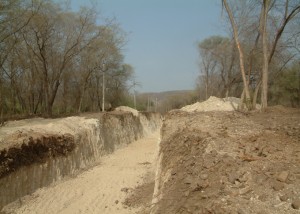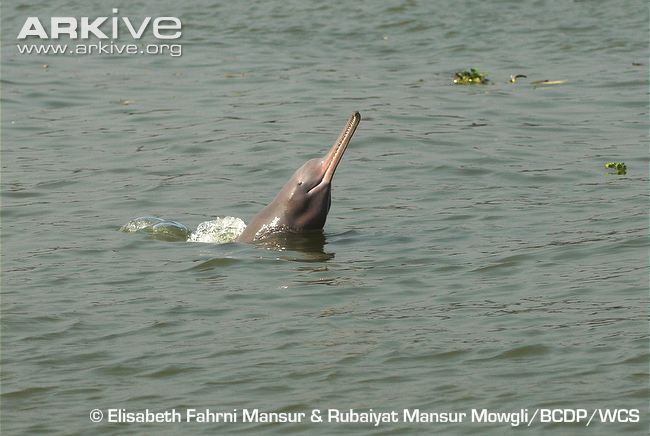 An under construction water canal at Ranthambore tiger Reserve is acting as a major hurdle for the tigers. Construction of the canal is underway in the South west corner of the park that will join the Kushalipura village nalla to the Mansarovar dam. If this is done, it will become a permanent border that will cut the crucial corridor that links Ranthambore National Park to the 128 sq km large Sawai Mansingh Sanctuary.
An under construction water canal at Ranthambore tiger Reserve is acting as a major hurdle for the tigers. Construction of the canal is underway in the South west corner of the park that will join the Kushalipura village nalla to the Mansarovar dam. If this is done, it will become a permanent border that will cut the crucial corridor that links Ranthambore National Park to the 128 sq km large Sawai Mansingh Sanctuary.
The Keladevi Sanctuary along with Ranthambore National park and the Sawai Mansingh Sanctuary form the important Ranthambore Tiger Reserve in the state of Rajasthan. The canal which is presently being constructed will hugely restrict the movement of the tiger as the site is a crucial corridor linking the entire reserve.
Man in Tiger Land
According to Tehelka’s investigative reports, the The two Protected Areas run parallel to each other for a distance of about 8-9 km but are already separated by the road linking Sawai Madhopur to Chambal. If the canal is constructed too, it will stop the chance of the tigers to spread and halt source population to spread to the outlining forests hampering their genetic diversity too.
Difficulties of creating a single tiger habitat has already risen here due to the presence of three villages and high hills on both sides of the roads. While superficially the Ranthambore tiger reserve seems like a sizable tiger habitat, it is already bisected in many places because of villages, roads and mountains.
The new canal will only bifurcate the forest even more and close a crucial corridor that wild animals frequently use to travel from the sanctuary to the national park and vice versa.
 Canal Controversy
Canal Controversy
As per the NGO Tiger Watch the foundation stone for the canal was laid by ex-forest minister and local MP Namo Narain Meena in April last year. National Tiger Conservation Authority (NTCA) member PK Sen visited the site in mid-May and found that close to 600 Dhonk trees had been felled and a deep trench more than 1.5 km long had been dug through the fragile forest.
The debris from the excavation had been dumped in the reserve area. He noted that the debris has high content of lime in it as is therefore stopping the growth of saplings on the top soil.
It was in October that the state government asked for clearance for the project by the Standing Committee of the National Board for Wildlife. They also requested the acquisition of 1.99 hectares of forest land for the purpose. This proposal had already been rejected twice in 2005-06.
According to Standing Committee member Prerna Bindra the committee objected to the project even during the October meeting.
“If the linkage is broken, the tigers have a doubtful future,” she said. “There should be accountability for bypassing the National Board for Wildlife. The construction started even though the project had been re-rejected by the committee, not once but twice and without the mandatory permissions.”
The state government says that the canal is required to provide five villages an additional of 77 million cubic feet. It will also eventually increase the size of Mansarovar Lake and submerge the surrounding forest.
On the other hand by diverting water, the Kushalipura nalla area will dry up affecting numerous wells in Bhairopura, Lakshmipura, Sawai Ganj and Badal Ganj.
Deadly Trap
Presently the underconstruction canal is a huge pit 10 m deep and 12 m wide. It is blocking the way of many wild animals and also posing a threat as a trap where small animals like chital, caracal etc. can easily fall. The government has proposed to partially cover the pit for free movement of the animals, but whether it will be really useful to the animals is uncertain.
Tiger Watch field biologist Dharmendra Khandal says, that it took years of effort to revive the tiger habitat of sawai Mansingh sanctuary and the recent birth of two cubs in the area is an incredible feat.
“Currently, the presence of six adult tigers and four cubs has been recorded in the sanctuary. Of these, four adult tigers and two cubs are known to be resident.”
In the present scenario then, all efforts would be lost if because of the canal, the tigers simply fail to reach out to the outlining forests and reside in the sanctuary apart from the ranthambore national park.
The excavation work is in violation of both the Wildlife Protection Act and the Forest Conservation Act and yet pressure seems to be mounting to allow the canal from diving the crucial forest cover. For now the project has been halted but if stricter measures are not taken anytime soon, tigers will lose yet another battle to survive.
Related Stories:
10 Endangered Species and Where to Find them in India









